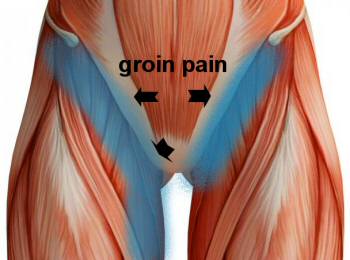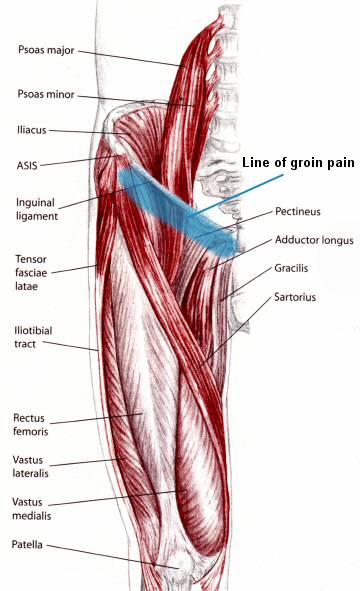The Haven
Healing Centre
The Orchard
Draycott Rd, Cheddar
Somerset

The Haven |

|
| Natural Complementary Therapies - your key to improved health and well-being | |
|
Home About Contact Gift Solutions Articles Treatments Products Page: 1 2 3 4 5 Appointments |
Upper Thigh Pain and Groin Strain TreatmentEffective treatment for the relief of groin pain and groin strainGroin pain can be really sore and affect your ability to walk, sit, run or just stand around doing nothing at all. The causes of groin pain can be many and varied. However,we can perhaps understand when it's because we have just won a race, chased after a bus, got the plants out to the garden, or cut the lawn, but when it comes for no reason, it can be perplexing to say the least, and sometimes frightening. Far too often, there is no obvious cause, but I have a theory. So many of us have sedentary jobs now that our hips spend large amounts of time in flexion, because of the way we sit at computers and phones, often for hours at a time. This causes your hams to stretch and your quads to relax. Over time, your quads only really move between toned enough to stand and relaxed during sitting.  The blood supply slows down to reflect the reduced demand for oxygen and the muscles atrophy a little at a time. Sometime later, you find you need to stand for long periods and this stretches the quad muscles, causing them to pull tightly against their attachment points on the pubis and ischium bones.
The blood supply slows down to reflect the reduced demand for oxygen and the muscles atrophy a little at a time. Sometime later, you find you need to stand for long periods and this stretches the quad muscles, causing them to pull tightly against their attachment points on the pubis and ischium bones.Previous atrophy means the stretch ability has been eroded and so the attachment points become tight, sore, pulled and strained. A strained muscle is squeezing the blood out of the muscle, which then becomes oxygen deficient. An oxygen deficient muscle soon becomes a painful muscle. This is the reason why massage and muscle stress release techniques are so effective. We also add into the mix Myofacial Release, Neuro-Muscular Therapy and Deep Tissue Release. They relax the muscle enough to engorge it with blood and oxygen, which clears out toxins and reduces the tendency to produce pain. The Muscles of the Hip Hip muscles are often divided into four groups according to their orientation around the hip joint: the gluteal group, the lateral rotator group, the adductor group, and the iliopsoas group. Gluteal group: The gluteal muscles include the gluteus maximus, gluteus medius, gluteus minimus, and tensor fasciae latae. The gluteus maximus, which forms most of the muscle of the buttocks, originates primarily on the ilium and sacrum and inserts on the gluteal tuberosity of the femur as well as the iliotibial tract, a band of strong fibrous tissue that runs along the outside of the thigh to the tibia and fibula, just below the knee. The gluteus medius and gluteus minimus originate in front of the gluteus maximus on the ilium and both connect to the greater trochanter of the femur. The tensor-fasciae latae shares its origin with the gluteus maximus at the ilium and also connects to the iliotibial tract. Adductor group: The adductor brevis, adductor longus, adductor magnus, pectineus, and gracilis make up the adductor group. They bring the body together by bringing the legs in toward the centre. Adductor muscles all originate on the pubis and insert on the medial, posterior surface of the femur, with the exception of the gracilis which inserts just below the medial condyle of the tibia. Iliopsoas group: The iliacus and psoas major comprise the iliopsoas group. These are important hip flexors and low back stabilizers. The psoas major is a large muscle that runs from the lumbar vertebrae, joins with the iliacus via its tendon, and connects to the lesser trochanter of the femur. The iliacus originates on the iliac fossa of the ilium. Together these muscles are commonly referred to as the "iliopsoas". Lateral rotator group: This group consists of the externus and internus obturators, the piriformis, the superior and inferior gemelli, and the quadratus femoris. These six originate at or below the acetabulum of the ilium and insert on or near the greater trochanter of the femur.  Movement of the hip joint: Flexion of the hip occurs when the knee is brought up towards the chest. This can often result in pain due to muscle contraction. Hip extension is when the leg moves farthest perpendicular to the hip, standing in other words. When this hurts it is extension pain and occurs when muscles and tendons are strained at their mooring points. Movement beyond normal standing, when the leg is placed behind you is called hip hyperextension, and pain when you do this is due to stretching the muscles. Moving your foot out to the side by swirling on the heel of your foot is called lateral rotation. Moving your foot in towards your other foot by swirling the heel of your foot is called medial rotation. Hip abduction occurs when the whole leg moves outward to the side. Hip adduction occurs when the leg moves back toward the midline. Because different muscles are responsible for all these movements, via the groups listed above, knowing where the pain is felt and what action you are doing when it occurs, tells us exactly which muscles are involved. That is very true in almost all cases, but in rare instances there is such a thing as referral pain, and this can take a little more investigation. Other hip muscles: Other muscles, such as the rectus femoris and the sartorius, can cause some movement in the hip joint. However these muscles are concerned primarily with the movement of the knee, and are accordingly not generally classified as muscles of the hip. However, they can have a profound impact on groin pain and so they deserve a mention here. As do the hamstring muscle group, which originates mostly from the ischial tuberosity inserting on the tibia/fibula, and has a large moment assisting with hip extension. Groin pain is extremely common amongst athletes especially in sports that require kicking, rapid accelerations and decelerations, and sudden direction changes, such as tennis, squash, rugby and football. Hip related groin pain can come from muscle strains, inguinal hernias, muscle tears, nerve entrapment and good old fashioned blunt force trauma. How will you treat me and what therapy will you use to treat me? First thing is to stop doing whatever it is that is causing you pain. Then you should apply ice for 10-15 minutes every half hour, to minimize the swelling and prevent further injury. Do this before you come for your assessment. I will assess the injury, or location of the pain, and develop an appropriate treatment/management plan to ensure you recover as quickly as possible. Next we will talk about how you can regain range of motion in your hip, thighs and knee joints, and what exercises may be appropriate for you. Considerations you will be shown how to overcome: This will include strength training for adductor, core and pelvic strength, increased flexibility training for adductors and the other hip muscles, proprioception observations (activities on uneven surfaces) and endurance training to build stamina in the repaired muscles. We will start with low weight exercises using high repetitions for maximum flexiblity, progressing to heavier weights with fewer repetitions as your pain subsides and your strength increases. Sometimes recovery progress can be a little slow, or slower than expected. As we've already explained above, this can be due (for example, in the case of adductor muscles) to a poor blood supply reaching the affected muscle. The manipulations and exercises given during treatment, and those you may be asked to continue yourself, will be those that best stimulate a good blood supply and therefore a good oxygen and nutrient supply to repair affected tissues and muscles. I will likely give you one or two very simple exercises to do at home. This is to complement your treatment and to create a degree of longevity into your treatment which means less time on the couch and more time doing the things you enjoy the most. Groin pain. Please contact me if you want to find out about appointments and prices. I look forward to welcoming you soon. Phil. Please share this page with your friends. Thank you.
Important Note: DISCLAIMER: This information is not presented by a medical practitioner and is for educational and informational purposes only. The content is not intended to be a substitute for professional medical advice, diagnosis, or treatment. Always seek the advice of your physician or other qualified health provider with any questions you may have regarding a medical condition. Never disregard professional medical advice or delay in seeking it because of something you have read. It's a small investment in yourself, but could be a life-changing experience you will cherish forever. |
| Copyright © Philip Chave 2008- TheHavenHealingCentre.co.uk All rights reserved. Email: privacy |